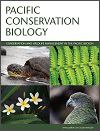Pacific Conservation Biology
Volume 30
Number 4 2024
Plant disease caused by the root pathogen Phytophthora cinnamomi has resulted in significant changes to susceptible plant communities in Two Peoples Bay Nature Reserve. The long history of the pathogen in the Reserve, with studies on disease distribution and impact dating from the 1980s, provides an opportunity to examine the past and present impact of P. cinnamomi on ecosystems.
This article belongs to the Collection The Natural History of Two Peoples Bay Nature Reserve, Western Australia.
Cultural changes could have important implications for conservation planning, and impact the success of conservation efforts. We studied the cultural divergence between the last remaining population of the Floreana mockingbird. Anticipating potential challenges caused by cultural divergence will increase the likelihood of success of the species reintroduction to Floreana Island on the Galápagos Islands.
Two case studies of ‘ecological forestry’ (‘community forestry’ in Victoria, and ‘ecological thinning’ in Western Australia) demonstrate the urgency to transition from resource-led to environment-led management in the restoration of post-production forests.
This study reports the first confirmed occurrence of a giant freshwater whipray in the Lesser Sunda region of Indonesia. The finding may confuse the species validity between Urogymnus dalyensis and its south-east Asian relative, U. polylepis. This observation suggests a possible population structure or the revelation of distinct species within the giant freshwater whipray complex, necessitating further investigations.
Reintroduction is a key strategy for re-establishing threatened species. Quenda (bandicoots, Isoodon fusciventer) were returned to the geographic and climatic margin of their former range after an absence of >40 years, persisting for more than 12 years despite drought and likely inter-and intra-specific competition for food resources. Minimising predation from foxes and feral cats was critical to the success.
We recorded 23 Ranong guitarfish (Rhinobatos ranongensis) in Southwest Aceh, Indonesia. Measured specimens ranged between 72 and 87 cm total length. There are 20 recorded guitarfish species (Genus Rhinobatos) and so far, three of them have been recorded in Indonesia: Jimbaran shovelnose ray (Rhinobatos jimbaranensis), Indonesian shovelnose ray (Rhinobatos pengali) and Shaw’s shovelnose guitarfish (Rhinobatos thouiniana). Rhinobatos ranongensis is listed as Vulnerable by IUCN and found in the Eastern Indian Ocean. The only recorded samples are from Andaman Sea, Myanmar and western Thailand. The specimens that landed in Southwest Aceh is the first recorded in Indonesia and the largest ever recorded.
This study provides an insight into the species of Chondrichthyes (sharks, rays, and chimaeras) present in the Samoan archipelago, an overview of their conservation, and the dynamics surrounding their management and social, cultural, and economic importance. It highlights current knowledge gaps and provides a foundation for further research to better understand chondrichthyan biodiversity and conservation.
Human–elephant conflicts occur frequently across countries within the elephant species range, but solutions remain elusive and are probably site-specific. In our study in western Thailand, pineapple received the most damage. Plantations further away from villages and those with larger areas of corn (an elephant-preferred crop) were associated with more crop damage. Based on local experience, planting multiple crops less preferred by elephants may reduce conflicts.





